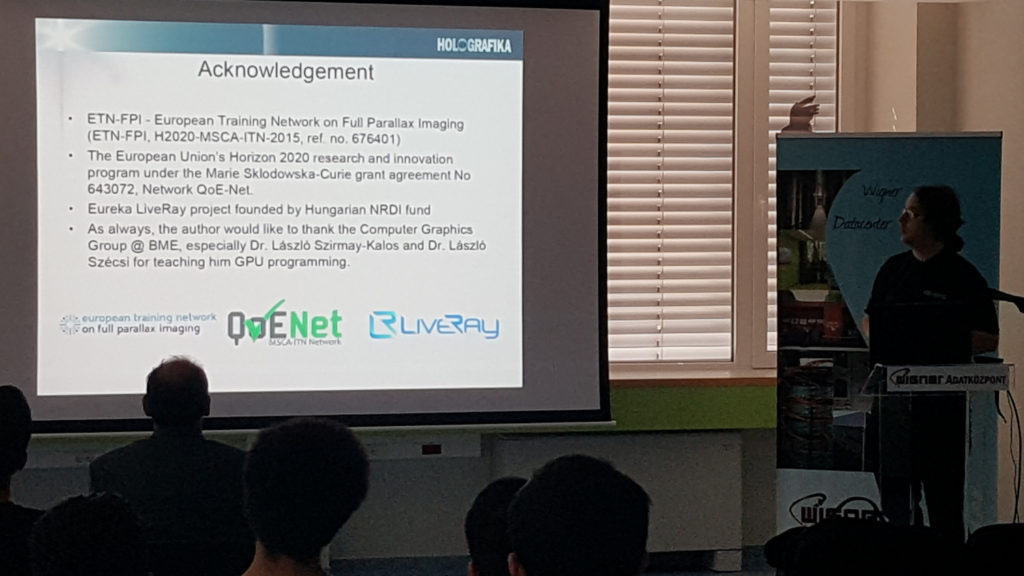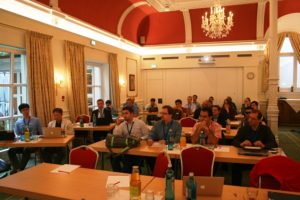Girls’ Day at Holografika – 04/2018
Technology demonstrations, creating interest among young girls aiming scientific career to improve gender balance.
GPU Day – 06/2017
Presentation for young scientists, the event is dedicated to the field of many-core computing in scientific and industrial applications
Girls’ Day at Holografika – 04/2017
Technology demonstrations, creating interest among young girls aiming scientific career to improve gender balance.
Global Shapers Budapest Hub (WEF) – 01/2017
An initiative backed by the World Economic Forum, the Global Shapers Community is a network of hubs developed and led by young people, primarily between the ages of 20 and 30 who are exceptional in their potential, their achievements and their drive to make a difference in their communities.
TUT Forum 11/2016, Tampere (Finland)
 3D-media group from Tampere University of Technology lead by Prof. Atanas Gotchev represented ETN-FPI at the TUT forum held in November 2016 in Tampere Hall, Tampere, Finland. The TUT forum is an annual event organized by TUT with aim of enabling better collaboration between university and industry. In addition to various technical presentations on the latest technological breakthroughs, the forum also enables research teams to show their latest results by means of demos.
3D-media group from Tampere University of Technology lead by Prof. Atanas Gotchev represented ETN-FPI at the TUT forum held in November 2016 in Tampere Hall, Tampere, Finland. The TUT forum is an annual event organized by TUT with aim of enabling better collaboration between university and industry. In addition to various technical presentations on the latest technological breakthroughs, the forum also enables research teams to show their latest results by means of demos.
Photonics Day at Holografika – 10/2016
DAY OF PHOTONICS is a biennial international event that promotes “photonics” towards the general public.
European Researchers’ Night 09/2016, Kiel (Germany)
Poster presentation on Full-Parallax Imaging
Professor Reinhard Koch and ESRs from Multimedia Information Processing (Christian-Albrecht-University Kiel) represented ETN-FPI in European Researchers’ Night 2016 (Kiel, Germany). The ERN was a great success in Kiel, and a few thousand people participated to the different activities. Close to 1000 visitors came around to ETN-FPI booth, which was conveniently located at the main entrance.
3DTV-CON 07/2016, Hamburg (Germany)
Several project beneficiaries represented the project in 3DTV-CON 2016, held on July 4–6, 2016 in Hamburg, Germany. 3DTV-CON 2016 was the 10th in a series of successful conferences having the objective to bring together researchers and developers from academia and industry with diverse experience and activity in distinct, yet complementary, areas to discuss the development of next generation 3D immersive and interactive technologies, applications and services. The conference involved a wide range of disciplines: imaging and computer graphics, signal processing, telecommunications, electronics, optics and physics. The conference consisted of tutorials, plenary talks, and special and regular sessions.
-
Tutorial “Light field – models, processing and compression” at 3DTV-Con 2016 (given by TUT and MIUN)
Detailed description available here. -
Workshop “Light Field Capture and Processing” at 3DTV-Con 2016
Detailed description available here.
“Synchronized data capture and calibration of a large-field-of-view moving multi-camera lightfield rig”
Presenters: Sandro Esquivel, Yuan Gao, Tim Michels, Luca Palmieri, Reinhard Koch; Multimedia Information Processing Group, Christian-Albrechts-Universität Kiel
Abstract: The processing of large spatio-temporal lightfields with room-size field of view requires the calibration and synchronized data capture with many video cameras in parallel. In our work we describe a large-scale 2D-scanning lightfield approach where 24 synchronized color cameras and two RGB-D cameras are aligned horizontally on a 2.5m rig that can be moved both horizontally and vertically to scan a planar lightfield of 5 square-meter size. We will discuss the issues and challenges of calibration, depth-color data capture and synchronized data processing.“Sensitivity Analysis of Time-of-Flight Sensor Fusion”
Presenters: Mårten Sjöström, Sebastian Schwarz* and Roger Olsson, Realistic 3D Group, Mid Sweden University, Sweden
* Now at Nokia TECH, Tampere, Finland
Abstract: The capture of a scene’s three-dimensional extension has become essential in many applications such as manufacturing control, surveillance, and entertainment. Dedicated range cameras are often combined with common RGB-video cameras to capture the scene’s three dimensions. The imposed physical displacement of the two capture devices requires spatial calibrations, and captured depth information must in a fusion process be up-sampled to meet the resolution of the RGB camera. This presentation focuses on the consequences of capture and estimation errors of an RGB and time-of-flight camera combination, and how the errors transplanted through the system may be considered in the image and depth fusion process.“A Linear Positioning System for Light Field Capture”
Presenters: Suren Vagharshakyan, Ahmed Durmush, Olli Suominen, Robert Bregovic, Atanas Gotchev; 3D Media Group, Tampere University of Technology, Finland
Abstract: We present a linear positioning system (LPS), which allows capturing wide field of view light fields with sub-pixel accuracy. We discuss a method for estimating the positions of a moving camera attached to that LPS. By comparing the estimated camera positions with the expected positions, which were calculated based on the LPS specifications, the manufacturer specified accuracy of the system, can be verified. Having this data, one can more accurately model the light field sampling process. Furthermore, we present an approach for sparsification of light field in shearlet transform domain and discuss its applicability for reconstruction of dense light fields from sparse set of cameras.“3D Light Field Cameras in Industry and Research”
Presenter: Dr. Christian Perwaß; Raytrix GmbH, Germany
Abstract: While the principle of light field cameras has been known for over 100 years, they have only recently made the step from being an object of research to becoming a tool for research and industry. The charm of light field cameras lies in the fact that 2D and 3D information can be captured in a single shot with a single camera through a single main lens. Very short exposure times, high speed recording and microscopy are therefore all in the application realm of light field cameras. The talk will give an introduction to the technology and discuss how light field cameras are applied in fields like optical metrology, particle imaging velocimetry and fluorescence microscopy.“Multi-Camera Production Systems for Visual Effects in Post-Production”
Presenter: Frederik Zilly; Computational Imaging Group, Fraunhofer IIS , Germany
Abstract: We present a system, which allows capturing the light field of a live action scene and thus offers full creative leeway of changing camera paths and orientation, as well as setting the focal plane in post-production. In contrast to previous approaches, the handling of the involved acquisition system is compact and thus suitable for on-set operation. Details about the test production, the underlying camera setup and post-production workflow are given in the presentation.
Kick-off meeting 10/2015, Tampere University of Technology (Finland)
ETN-FPI kick-off meeting was co-located with the CIVIT (Centre for immersive visual technologies) opening event. Project beneficiaries and partners took an active part in the opening event through presentations and demonstrations.









